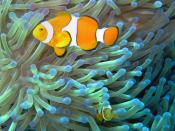The concept of two organisms belonging to different species that live together and benefit from a relationship is a symbiotic relationship.
There are different types of Symbiotic relationships: -
Commensalisms: - In commensalisms one species of symbiotic relationship benefits while the other is neither helped nor hurt. In this relationship the species which does not gain benefit is totally unaffected, because it does not do anything intentionally to provide the other species with any kind of benefit. There can be many examples of a commensalism relationship to name but a few there are those of a Cattle Egret, Anemone fish, Barnacles, Pseudo scorpions, Monarchs and Viceroys and lastly that of Burdocks.
Mutualism: - In this kind of symbiosis both the species involved gain benefits from this relationship. An example of this kind of relationship would be one between the crab and the algae. Algae live on crabs, and with algae covering the crab, the crab is hidden from its predators as it gets a camouflage and cannot be seen.
By this symbiotic relationship of mutualism both the crab and the algae benefit because while the algae gets a place to live where as the crab gets a chance to live because it is safe from other larger sea creatures which feed on it.
Parasitism: - In this symbiotic relationship the parasite (eg. Bacteria) inflicts harm upon the prey on which it resides, the parasite benefits from the relationship while the host organism gets harmed. There are two types of parasites, Ectoparasites which live externally on the host, and endoparasites which live internally in the host. An example to illustrate an endoparasite would be the bacteria which live in the intestines of mammals; these can lead to various intestinal diseases and other blood disorders, as they introduce foreign...


